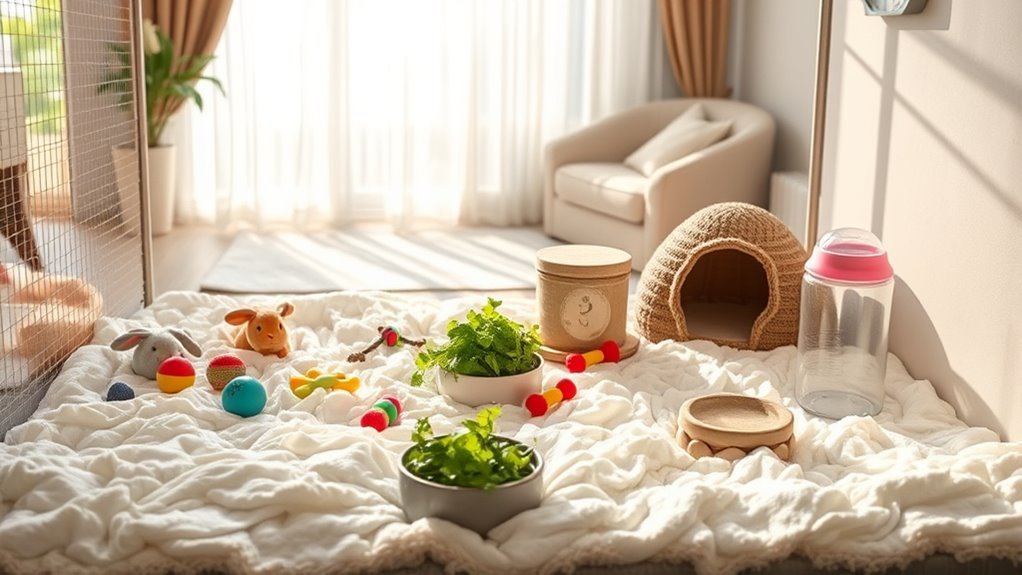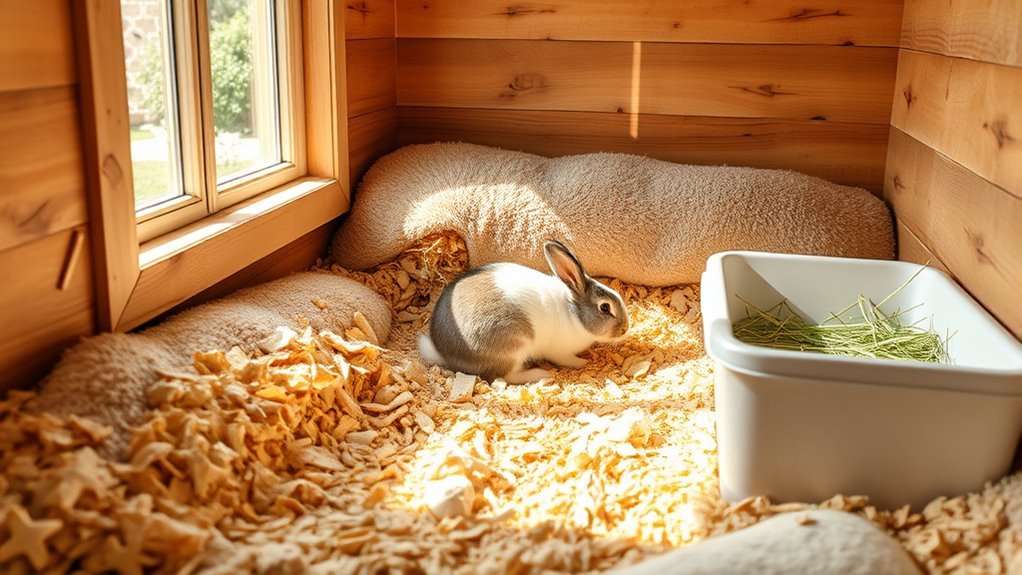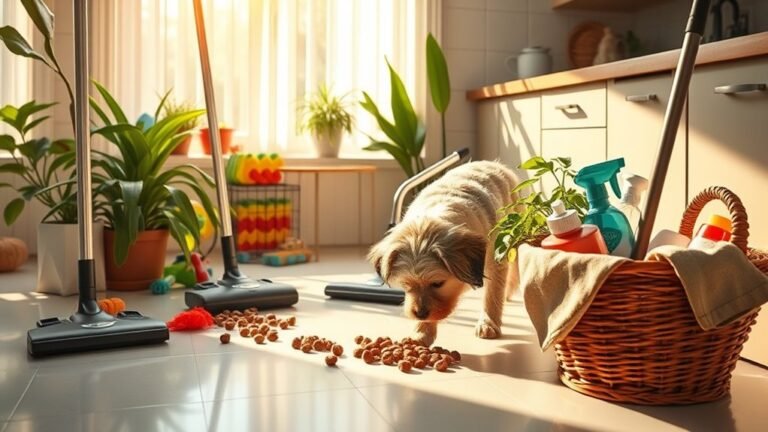Maintaining a Clean Space for Indoor Rabbits
To keep your indoor rabbit healthy and happy, choose spacious, secure housing with solid flooring and soft bedding. Scoop the litter daily, wipe soiled spots, and refresh food and water regularly. Use easy-to-clean bedding like paper or straw to manage odors naturally, and opt for safe cleaning products like diluted vinegar. Maintaining good ventilation also helps prevent smells. If you want to create the best clean, comfortable environment for your bunny, there’s plenty more helpful advice ahead.
Choosing the Right Housing for Your Indoor Rabbit

While picking a home for your indoor rabbit, you’ll want to focus on safety, comfort, and space. You don’t want to confine your bunny too tightly; freedom to hop and stretch is key. Explore rabbit housing options like spacious pens or custom enclosures that provide enough room for movement and play. Make certain the area is secure, free from electrical cords or sharp edges, to guarantee indoor rabbit safety. Avoid wire-bottom cages—they can hurt your rabbit’s feet. Instead, opt for solid flooring with soft bedding. Your rabbit’s housing should also allow easy access to food, water, and hiding spots where they can feel safe and relaxed. Choosing the right setup means your rabbit enjoys freedom within a secure, comfortable environment.
Daily Cleaning Tasks to Keep Your Rabbit’s Space Fresh
Because rabbits are naturally clean animals, keeping their space fresh only requires a few daily tasks. Start by scooping the litter box each morning to remove waste; this prevents odors and keeps your rabbit happy. Wipe down any soiled areas around the cage or playpen with a damp cloth. Stick to a consistent cleaning schedule to avoid buildup—this routine helps you stay on top of messes without feeling overwhelmed. Refresh water bowls and check food dishes daily to maintain hygiene. Allow your rabbit some freedom by keeping its environment inviting and clean, encouraging natural behaviors. These simple, regular steps guarantee your indoor bunny’s space remains fresh, comfortable, and enjoyable for both of you.
Best Bedding Materials for Easy Maintenance

Choosing the right bedding material can make cleaning your rabbit’s space much easier and more efficient. Paper bedding is a popular choice because it’s highly absorbent, controls dust well, and can be changed out quickly, helping you maintain a fresh environment with less hassle. If you prefer natural options, straw options offer great insulation and comfort, though they might require more frequent spot cleaning to manage messes. Both materials support your rabbit’s freedom to move and burrow without trapping odors or moisture. Avoid bedding that’s dusty or difficult to scoop, as it can complicate maintenance and restrict your rabbit’s comfort. By selecting easy-to-manage bedding like paper or straw, you’ll enjoy a cleaner space with less effort, giving your rabbit a healthy, inviting home.
Managing Odors in Your Rabbit’s Living Area
Good bedding helps control moisture and odors, but it’s only part of keeping your rabbit’s living area fresh. To truly master odor control, you need to clean regularly and provide proper ventilation. Change soiled bedding promptly and spot-clean daily to prevent buildup. You can also sprinkle natural deodorizers like baking soda or activated charcoal around the cage, but avoid direct contact with your rabbit. These natural options absorb smells without harmful chemicals, letting your space stay fresh and safe. Remember, fresh air circulation is key; open windows or use a small fan to reduce stagnant odors. With these steps, you’ll create a comfortable, odor-free environment that supports your rabbit’s freedom and well-being without confining scents or discomfort.
Safe Cleaning Products for Rabbit Habitats

While keeping your rabbit’s habitat clean is essential, you’ll want to be careful about the products you use. Many conventional cleaners contain harmful substances that can irritate your rabbit’s sensitive respiratory system or damage their delicate skin. Instead, opt for natural cleaners like diluted vinegar, baking soda, or gentle castile soap. These options effectively break down messes without exposing your bunny to toxic chemicals. Always rinse thoroughly and let the area dry completely before letting your rabbit back in. Avoid anything with strong fragrances, bleach, ammonia, or harsh detergents, as these can be dangerous. By choosing safe, natural cleaners, you’re giving your rabbit the freedom to explore their space without risking their health or your peace of mind. Clean smart, and keep your rabbit’s habitat safe and fresh.
Organizing Feeding and Water Stations for Cleanliness
Because rabbits can be messy eaters, keeping their feeding and water stations well-organized is key to maintaining a clean habitat. Set up designated spots for food and water, using sturdy bowls that won’t tip easily. Stick to consistent feeding schedules to avoid leftover food piling up, which can attract pests or cause odor. Fresh water is essential, so change it daily to preserve water quality and keep your rabbit hydrated and healthy. Consider placing a mat under the feeding area to catch spills; it’s easier to clean and prevents mess from spreading. By organizing these stations thoughtfully, you create a freer space for your rabbit to eat without unnecessary clutter or contamination, making your home cleaner and your pet happier.
Tips for Regular Deep Cleaning and Disinfection
Although regular spot cleaning keeps your rabbit’s space tidy, you’ll need to perform deep cleaning and disinfection regularly to maintain a healthy environment. Start by removing all bedding, toys, and accessories. Use pet-safe sanitation techniques like diluted white vinegar or specialized cleaners to scrub surfaces, eliminating odors and harmful bacteria. Pay close attention to corners and hidden spots where dirt accumulates. Rinse thoroughly and let everything dry completely before returning items. Aim to deep clean at least once a week, adjusting frequency based on your rabbit’s activity. This routine not only protects your bunny’s health but also keeps their space fresh and inviting. By committing to these sanitation techniques, you give your rabbit the freedom to explore a clean, safe environment every day.
Frequently Asked Questions
How Often Should I Replace My Rabbit’S Bedding Completely?
They say, “A stitch in time saves nine,” and when it comes to bedding materials, that couldn’t be truer. You should completely replace your rabbit’s bedding at least once a week to keep their space fresh and healthy. Depending on your cleaning frequency and your bunny’s habits, you might need to swap it out more often. This routine lets your rabbit roam freely without the burden of dirt or odors weighing them down.
Can Indoor Rabbits Be Litter Trained Effectively?
Yes, indoor rabbits can be litter trained effectively! With patience and the right training techniques, you’ll find your bunny quickly learns to use a litter box. Start by placing the box where your rabbit naturally goes, using familiar bedding inside. Reward them when they use it correctly, and avoid punishment. This freedom-friendly approach lets your rabbit roam with less worry about messes, making life easier for both of you.
What Signs Indicate My Rabbit’S Habitat Needs More Frequent Cleaning?
You’ll know your rabbit’s habitat needs more frequent cleaning if you start noticing a strong odor or if the area looks messy despite sticking to your usual cleaning schedule. Odor control is key to keeping both you and your bunny comfortable. If smells linger or bedding gets damp quickly, it’s time to freshen up more often. Trust your instincts—adjusting your routine keeps the space fresh without feeling restrictive.
Are There Any Health Risks From Using Certain Cleaning Products Around Rabbits?
It’s best to avoid “overly enthusiastic” cleaning products around rabbits, as many contain harsh chemicals that can quietly threaten your pet’s wellbeing. You’ll want to stick to safe cleaning options like diluted vinegar or specially formulated rabbit-safe cleaners. These protect rabbit health without confining you to sterile spaces. By choosing gentle, natural products, you guarantee a fresh environment while letting your rabbit enjoy freedom and comfort without invisible risks lurking nearby.
How Do I Prevent Mold Growth in My Rabbit’S Enclosure?
To prevent mold growth in your rabbit’s enclosure, focus on mold prevention and humidity control. Keep the space dry by cleaning up any spills quickly and ensuring good ventilation. Use a dehumidifier or open windows when possible to reduce moisture levels. Avoid overcrowding bedding, which traps dampness. By managing humidity and keeping things clean, you’ll create a healthier, fresher environment for your bunny to enjoy without restrictions.






